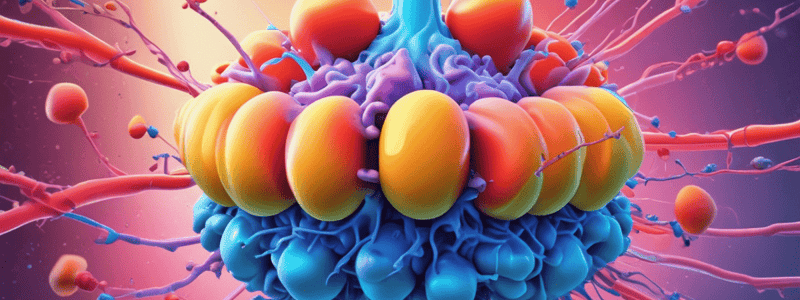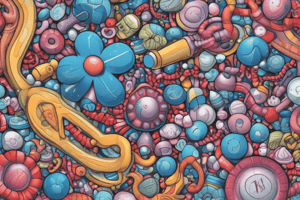Podcast
Questions and Answers
Which transporter can transport glucose against its concentration gradient?
Which transporter can transport glucose against its concentration gradient?
- SGLT-1 (correct)
- GLUT
- Na+/H+ antiporter
- Na+/K+-ATPase
What is the central ATP-producing pathway in most organisms?
What is the central ATP-producing pathway in most organisms?
- Glycolysis (correct)
- Citric acid cycle
- Gluconeogenesis
- Electron transport chain
Which process involves the reduction of pyruvate to lactate in eukaryotic cells under anaerobic conditions?
Which process involves the reduction of pyruvate to lactate in eukaryotic cells under anaerobic conditions?
- Citric acid cycle
- Gluconeogenesis
- Fermentation (correct)
- Oxidative phosphorylation
What is the energy-requiring enzyme that maintains the Na⁺ gradient to facilitate SGLT cotransport?
What is the energy-requiring enzyme that maintains the Na⁺ gradient to facilitate SGLT cotransport?
Where does glycolysis primarily occur in most organisms?
Where does glycolysis primarily occur in most organisms?
Which process does not depend on oxygen for ATP production?
Which process does not depend on oxygen for ATP production?
What is the primary fate of ACETYL-COA in the mitochondria?
What is the primary fate of ACETYL-COA in the mitochondria?
Which of the following is NOT a way that metabolism is regulated?
Which of the following is NOT a way that metabolism is regulated?
What is the primary purpose of the GLUT transporters for glucose?
What is the primary purpose of the GLUT transporters for glucose?
Which of the following cellular processes is NOT driven by the catabolism of carbohydrates?
Which of the following cellular processes is NOT driven by the catabolism of carbohydrates?
Which type of GLUT transporter is responsive to insulin?
Which type of GLUT transporter is responsive to insulin?
How do intracellular signals coordinate metabolic functions?
How do intracellular signals coordinate metabolic functions?
What is the primary purpose of fermentation in the body?
What is the primary purpose of fermentation in the body?
Which of the following tissues or cell types is MOST likely to rely on anaerobic glycolysis for energy production?
Which of the following tissues or cell types is MOST likely to rely on anaerobic glycolysis for energy production?
What is the primary fate of lactate produced during anaerobic glycolysis?
What is the primary fate of lactate produced during anaerobic glycolysis?
In the presence of oxygen, what happens to the pyruvate produced during glycolysis?
In the presence of oxygen, what happens to the pyruvate produced during glycolysis?
What is the primary purpose of the electron transport chain (ETC) in aerobic respiration?
What is the primary purpose of the electron transport chain (ETC) in aerobic respiration?
Which of the following is the MOST important factor in regulating glucose metabolism?
Which of the following is the MOST important factor in regulating glucose metabolism?
In metabolism, which type of pathway involves the breakdown of molecules into smaller units that can be oxidized to release energy?
In metabolism, which type of pathway involves the breakdown of molecules into smaller units that can be oxidized to release energy?
What is the primary purpose of anabolic pathways in cellular metabolism?
What is the primary purpose of anabolic pathways in cellular metabolism?
During catabolism for ATP production, what is the primary fate of acetyl-CoA in the mitochondria?
During catabolism for ATP production, what is the primary fate of acetyl-CoA in the mitochondria?
Which term best describes pathways in metabolism that end up with the regeneration of a component?
Which term best describes pathways in metabolism that end up with the regeneration of a component?
What is the sum of all chemical reactions occurring in a cell, a tissue, or a body known as?
What is the sum of all chemical reactions occurring in a cell, a tissue, or a body known as?
Which of the following is the primary function of the TCA cycle in cellular metabolism?
Which of the following is the primary function of the TCA cycle in cellular metabolism?
What is the primary role of the electron transport chain (ETC) in aerobic respiration?
What is the primary role of the electron transport chain (ETC) in aerobic respiration?
Which of the following is the MOST important factor in regulating glucose metabolism?
Which of the following is the MOST important factor in regulating glucose metabolism?
What is the primary fate of the pyruvate produced during glycolysis in the presence of oxygen?
What is the primary fate of the pyruvate produced during glycolysis in the presence of oxygen?
Which of the following is a key regulatory mechanism for coordinating metabolic functions in the body?
Which of the following is a key regulatory mechanism for coordinating metabolic functions in the body?
What is the primary purpose of the GLUT transporters for glucose in the body?
What is the primary purpose of the GLUT transporters for glucose in the body?
What is the primary function of the ACETYL-COA molecule in cellular metabolism?
What is the primary function of the ACETYL-COA molecule in cellular metabolism?
Which of the following is the MOST important regulatory mechanism for coordinating cellular metabolism?
Which of the following is the MOST important regulatory mechanism for coordinating cellular metabolism?
What is the primary fate of lactate produced during anaerobic glycolysis in most tissues?
What is the primary fate of lactate produced during anaerobic glycolysis in most tissues?
What is the primary purpose of the electron transport chain (ETC) in aerobic respiration?
What is the primary purpose of the electron transport chain (ETC) in aerobic respiration?
Which of the following cellular processes is NOT driven by the catabolism of carbohydrates?
Which of the following cellular processes is NOT driven by the catabolism of carbohydrates?
In which process does the conversion of pyruvate to acetyl-CoA occur?
In which process does the conversion of pyruvate to acetyl-CoA occur?
Which of the following pathways is primarily responsible for the production of ATP in the presence of oxygen?
Which of the following pathways is primarily responsible for the production of ATP in the presence of oxygen?
What is the primary fate of acetyl-CoA produced during the oxidative decarboxylation of pyruvate?
What is the primary fate of acetyl-CoA produced during the oxidative decarboxylation of pyruvate?
What is the primary purpose of the citric acid cycle (Krebs cycle)?
What is the primary purpose of the citric acid cycle (Krebs cycle)?
Which of the following processes is primarily involved in the regulation of glucose metabolism?
Which of the following processes is primarily involved in the regulation of glucose metabolism?
What is the primary regulator of glycolysis and the entry of pyruvate into the mitochondria?
What is the primary regulator of glycolysis and the entry of pyruvate into the mitochondria?
Which of the following pathways is responsible for the complete oxidation of glucose under aerobic conditions?
Which of the following pathways is responsible for the complete oxidation of glucose under aerobic conditions?
What is the primary fate of acetyl-CoA produced from the oxidation of pyruvate in the mitochondria?
What is the primary fate of acetyl-CoA produced from the oxidation of pyruvate in the mitochondria?
Which of the following processes is an anabolic pathway that can utilize the products of glucose catabolism?
Which of the following processes is an anabolic pathway that can utilize the products of glucose catabolism?
In which tissue or cell type would anaerobic glycolysis be most prevalent?
In which tissue or cell type would anaerobic glycolysis be most prevalent?
Which of the following accurately describes the regulation of glucose metabolism?
Which of the following accurately describes the regulation of glucose metabolism?
Which of the following statements about glycolysis is correct?
Which of the following statements about glycolysis is correct?
What is the primary role of the Na⁺/K⁺-ATPase enzyme?
What is the primary role of the Na⁺/K⁺-ATPase enzyme?
Under anaerobic conditions, what is the fate of the NADH produced during glycolysis in eukaryotic cells?
Under anaerobic conditions, what is the fate of the NADH produced during glycolysis in eukaryotic cells?
Which of the following pathways is primarily responsible for the oxidation of acetyl-CoA?
Which of the following pathways is primarily responsible for the oxidation of acetyl-CoA?
Which of the following statements about GLUT transporters is correct?
Which of the following statements about GLUT transporters is correct?
What is the primary purpose of fermentation in the body?
What is the primary purpose of fermentation in the body?
Which of the following is NOT a product of glycolysis?
Which of the following is NOT a product of glycolysis?
In the presence of oxygen, what is the primary fate of the pyruvate produced during glycolysis?
In the presence of oxygen, what is the primary fate of the pyruvate produced during glycolysis?
Which of the following statements about the SGLT-1 transporter is correct?
Which of the following statements about the SGLT-1 transporter is correct?
Flashcards are hidden until you start studying
Study Notes
Glucose Transport
- Glucose cannot diffuse into cells, it must be transported by transporters
- Two types of glucose transporters:
- GLUT transporters: passive system, do not require ATP, highly tissue specific, some are insulin responsive (GLUT 4)
- SGLT-1 transporter: Na⁺-dependent cotransporter, can transport glucose against its concentration gradient, ATP-dependent antiport system Na+/K+- ATPase (pump)
Glycolysis
- Central ATP-producing pathway, takes place in cell cytosol in all tissues
- Highly regulated process, just enough glucose is metabolized to meet the cell’s need for ATP
- Does not depend on oxygen
- Net gain: 2 pyruvate + 2 NADH + 2 ATP
- Can be aerobic or anaerobic, red blood cells and muscle take advantage of anaerobic glycolysis
Anaerobic Glycolysis
- NADH unloads H⁺ on pyruvate, reducing it to lactate (in eukaryotic cells)
- Pyruvate reduced to lactate → Fermentation
- Occurs in cells with low mitochondria density and poorly vascularized tissues (cornea, lens), skeletal muscle (white fibers), and cells lacking mitochondria (erythrocytes)
- LDH=lactate dehydrogenase
Aerobic Glycolysis
- Pyruvate enters the mitochondria, converted into acetyl-CoA (link reaction)
- NADH unloads H⁺ → ETC → regenerate NAD+
- Approximately 42% of the energy of glucose is captured in the form of ATP
- Remaining energy in glucose generates heat, aiding in the regulation of body temperature
- Eventually, all energy derived from glucose oxidation is released as heat after ATP is used up
Fates of Pyruvate
- 4 possible fates:
- Pyruvate reduction to lactate (fermentation)
- Pyruvate reduction to ethanol (fermentation)
- Oxidative decarboxylation to acetyl-CoA
- Pyruvate carboxylation to oxaloacetate (OAA)
Metabolism
- Cellular reactions rarely occur in isolation, but as part of pathways that are multi-step sequences
- One product serves as the substrate of the next reaction
- Catabolic (degradative) pathways break down molecules into smaller units, anabolic (synthetic) pathways combine small molecules to form more complex molecules
- Metabolism is the sum of all chemical reactions occurring in a cell, tissue, or body
Regulation of Metabolism
- Available nutrients, hormones, and neurotransmitters provide regulatory signals to coordinate metabolic functions
- Intracellular communication: substrates availability, product inhibition, activators/inhibitors
- Intercellular communication: direct cell surface contact, gap junctions, chemical signaling (hormones, neurotransmitters)
- Second messenger system: signal transduction and cellular response (GPCR)
TCA Cycle
- Final pathway where carbohydrates, amino acids, and fatty acids converge
- Energy provided by the TCA cycle is essential for most animals, including humans
- TCA cycle location: mitochondria matrix
- 2 carbons enter as acetyl-CoA, 2 leave as CO2
- Aerobic because oxygen is the final electron acceptor (in ETC)
Oxidative Phosphorylation
- Energy-rich molecules (glucose, fatty acids) are metabolized by a series of oxidation reactions into ATP, CO2, and H2O
- Reaction metabolic intermediates donate electrons to specific coenzymes: NAD+ & FAD → forms energy-rich reduced forms NADH & FADH2
- NADH and FADH2 donate a pair of electrons to the Electron Transport Chain (ETC) → located on the mitochondria inner membrane
- Oxidative Phosphorylation = Electron Transport Chain (ETC) + ATP synthesis
Studying That Suits You
Use AI to generate personalized quizzes and flashcards to suit your learning preferences.




